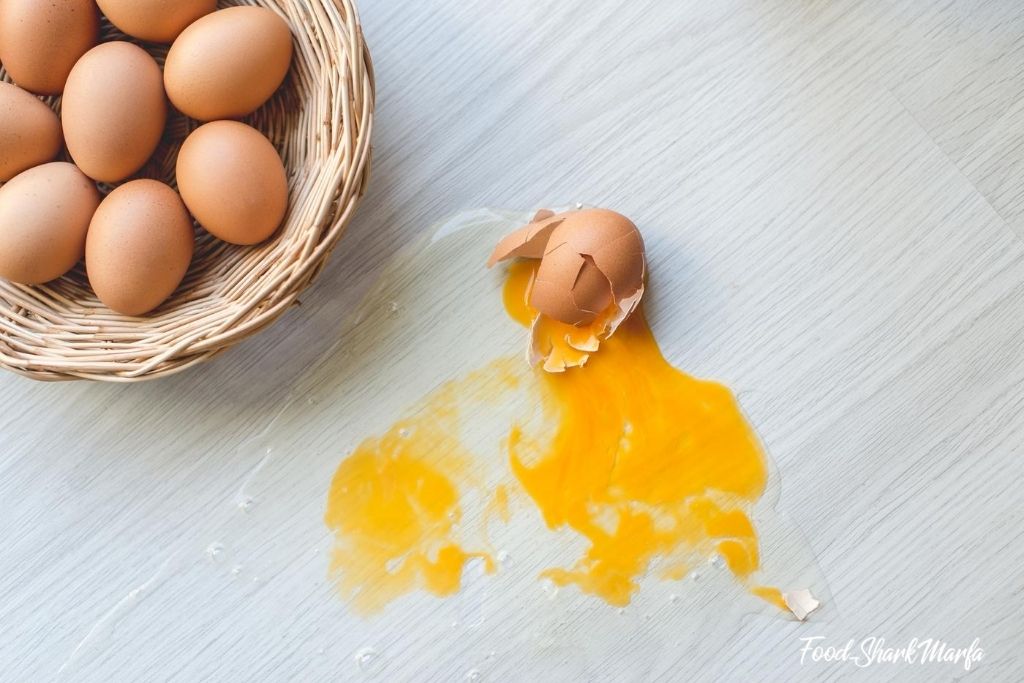If you want fast protein in the morning before leaving for work, then make ahead scrambled eggs may just be the answer.

There are concerns that it is dangerous or toxic to reheat scrambled eggs, as eggs are a common source of foodborne illness in the form of Salmonella. However, you can reheat scrambled eggs if you follow basic food safety principles for handling, storing, cooking and reheating the scrambled eggs. Scrambled eggs will keep in the refrigerator for up to four days before being reheated.
To learn more about how to store, cook and reheat scrambled eggs safely to minimize any risk of foodborne illness, continue reading.
Basic Food Safety Tips for Scrambled Eggs
The CDC estimate that around one in 50 of us is exposed to a bad egg every year, but, as long as you follow basic food safety principles, it is not toxic or dangerous to reheat scrambled eggs and any risk of foodborne illness is very low.

Salmonella can be found in normal eggs but this bacteria does not cause any problems unless eggs are not stored properly, undercooked, or if utensils, equipment and surfaces are not cleaned/disinfected properly after you have been handling the raw eggs.
Salmonella causes cramps, diarrhea and fever and the illness can last for up to a week.
When you buy eggs, buy them from a refrigerated case or refrigerator and open the pack to check that the shells are not damaged, and that the eggs are clean.
Once you get them home, put the carton straight into the refrigerator and use the carton within three weeks to ensure the eggs are at best quality. When eggs are stored in the refrigerator below 40°F it prevents bacteria from reproducing.
Make sure your scrambled eggs are fully cooked, so they are firm rather than runny and have reached the safe internal temperature of 160°F as tested with a thermometer. When eggs are fully cooked, any surviving bacteria in the eggs die off.
Scrambled eggs should be served immediately or cooled quickly and placed into the refrigerator once cool. When you come to reheat them, they should be reheated to a safe internal temperature of 165°F.
When preparing and cooking any egg dishes, once you have prepared the eggs, sanitize surfaces properly and clean utensils and bowls with hot soapy water.
How to Cook Scrambled Eggs to Reheat Later
Scrambled eggs for reheating later are always best cooked on the stovetop and should be cooked to a minimal internal temperature of 160°F.

If you cook them initially in the microwave and then reheat them, you may find they are not only rubbery, but dried out as well.
How to Cool Scrambled Eggs Safely Before Refrigerating
Once you have cooked your scrambled eggs, leave them on the countertop to cool. You want the egg to cool as quickly as possible, so if you have made a large serving, split it into smaller and shallower dishes so that it can cool quickly. According to the US FDA, scrambled egg or any other type of egg dish should never be at room temperature for more than two hours, or one hour if the room temperature is above 90°F as otherwise, bacteria such as salmonella will grow and reproduce at these temperatures - increasing the risk of foodborne illness.
Generally, as eggs do cool quickly, you can just leave them on the countertop for a little while – 15 to 30 mins - then place the lid on your container, or use plastic wrap or aluminum foil to cover the bowl and place it in the refrigerator.
How Long Will Scrambled Eggs Keep in The Refrigerator For?
Scrambled eggs will keep for three to four days in the refrigerator. Do not store them near the door of the refrigerator because of temperature fluctuations. Do not keep scrambled eggs for any longer than four days in the refrigerator and even within this timeframe, check the eggs for any off odors before using. If in doubt, throw them out!
What is The Best Way to Reheat Scrambled Eggs?
You can reheat scrambled egg in the microwave, on the stovetop or in the oven.
Whichever way you reheat your scrambled eggs, always make sure the internal temperature hits 165°F as measured with a good quality thermometer and once your eggs have been reheated, serve immediately and dispose of any leftovers as it is not safe to reheat them again.
Reheating Scrambled Eggs in The Microwave
To reheat in the microwave, place the refrigerated scrambled egg into a microwave safe container. If the eggs look a little dry, you can add a little milk or other suitable liquid. Place the lid (or a piece of microwave-safe plastic wrap) loosely over the container and heat the eggs for 20 seconds.
After 20 seconds, take out the eggs, stir with a fork and return to the microwave for another 20 seconds. Take them out once more, stir and also check the temperature with a thermometer. Keep repeating the heating blasts, stirring and temperature checks until the eggs are reheated to a safe internal temperature of 165°F.
If there is excess liquid in the eggs while reheating, just drain it off. Do keep an eye on scrambled eggs when reheating in the microwave though as if they do overcook, they will become rubbery.
Reheating Scrambled Eggs on The Stovetop
To reheat scrambled eggs on the stovetop, add some fat to a fry pan and heat up. Once the fat is hot, add the scrambled eggs from the refrigerator and leave the heat set at low-medium. Place a lid on the fry pan as this allows the eggs to reheat without drying out as much. Stir the eggs frequently to stop them from sticking or overcooking.
It should take around five minutes to reheat them to 165°F this way, depending of course on how much you are reheating.
If there is excess liquid at the bottom of the pan, you can drain it off. It is also easier to add extra ingredients such as peppers, cooked ham, mushrooms or cheese when you reheat scrambled eggs on the stovetop.
Reheating Scrambled Eggs in The Oven
Scrambled eggs can also be reheated in the oven although this does take longer. Reheat scrambled eggs in a covered oven safe dish or add the eggs to the center of a piece of aluminum foil and make a sealed pouch around the eggs. Once the eggs are wrapped, place in the oven at 300°F and check them regularly as they will be ready to serve within 15 to 30 minutes – depending on quantity of eggs reheated.
Once the scrambled eggs are reheated to the safe internal temperature of 165°F, serve immediately.
Can You Freeze Then Reheat Scrambled Eggs?
Yes, you can freeze and then reheat scrambled eggs for longer term storage. Scrambled eggs should be frozen in ziplock bags or airtight containers as soon as they are fully cool and will keep at best quality in the freezer for up to six months.
When you are ready to reheat frozen scrambled eggs, thaw them out in the refrigerator before reheating on the stovetop, in the microwave or the oven. Just ensure they are fully heated to the safe internal temperature of 165°F and serve up immediately.
In Summary
In this post, I have shown that you can make scrambled eggs ahead of when you need them and store them in the refrigerator for up to four days before reheating them - ideal for fast breakfasts. You can also store scrambled eggs in the freezer for up to six months.
As long as you store your eggs correctly, cook them to a minimal internal temperature of 160°F, cool them quickly and reheat to a safe internal temperature of 165°F in the microwave, on the stovetop or in the oven, then the risk of acquiring a foodborne illness such as Salmonella is very low.


